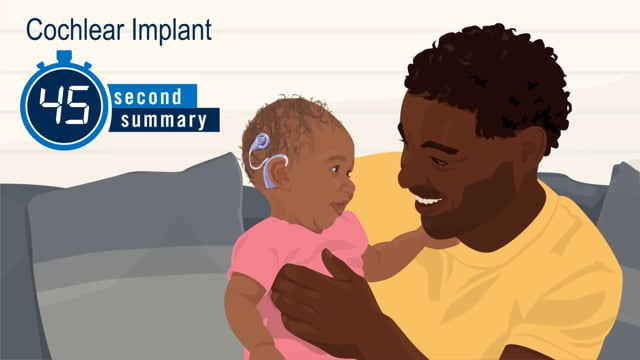What Are Cochlear Implants?
A cochlear implant is a surgically placed device that helps a person with severe hearing loss hear sounds.
The cochlea is a snail-shaped part of the inner ear. It turns sound vibrations into electrical signals that travel along the auditory (hearing) nerve. The brain translates these signals into recognizable sounds.
Cochlear (KOE-klee-er) implants are different from hearing aids:
- A hearing aid makes sounds louder so people with hearing loss can hear.
- Cochlear implants bypass damaged parts of the cochlea to stimulate the auditory nerve directly. They may help when a hearing aid can't.
-

45-Second Summary: Cochlear Implant
Learn the basics in 45 seconds.
How Do Cochlear Implants Work?
Cochlear implants have:
- A microphone and speech processor that sit outside the body. The microphone picks up sound and sends it to the processor. The processor is a minicomputer that changes the sound into digital information. Then, a transmitter sends the digital signal to the receiver/stimulator.
- A receiver/stimulator that's placed under skin and muscle behind the ear. This gets information from the processor. It sends electrical impulses by a thin wire to electrodes placed in the cochlea. The electrodes stimulate the auditory nerve. The message goes to the brain and the brain can use the information to recognize sounds and understand speech.
Is Hearing With a Cochlear Implant Like Normal Hearing?
Sound quality from a cochlear implant is different from that in normal hearing. That's because a limited number of electrodes take over the work of the thousands of hair cells in a normal cochlea. The sounds a child hears won't be totally "natural."
But cochlear implants let someone sense sound that they couldn't hear otherwise. Infants who never heard before soon will build new brain pathways to start to make sense of these sounds. With therapy and practice, all kids can learn how to interpret these sounds to better understand speech.
Who Can Get a Cochlear Implant?
Cochlear implants are considered for children with profound hearing loss who can be as young as 9 months old.
A cochlear implant team will help decide if cochlear implants are a good option. This team includes an audiologist (hearing specialist), an ear-nose-throat (ENT) doctor, a speech therapist, a psychologist, and a social worker.
Kids being considered for the surgery will:
- get hearing tests
- have speech/language evaluations
- use a hearing aid for a while to see if it helps
- get computed tomography (CT) or magnetic resonance imaging (MRI) scans to look at the inner ear and the bones that surround it
Kids might not get the implants if:
- Their hearing is "too good" (they can hear some sound and speech with hearing aids).
- Their hearing loss isn't due to a problem with the cochlea.
- They've been profoundly deaf for a long time.
- The auditory nerve is damaged or absent.
What Happens During Cochlear Implant Surgery?
Cochlear implant surgery is done under general anesthesia. The child will sleep through the surgery and not feel pain.
The surgeon:
- Makes an incision (cut), then places the implant under the skin and inside the skull.
- Threads the wires with the electrodes into the spirals of the cochlea.
- Secures the implant in place and closes the incision with stitches.
Depending on a child's hearing, the doctor may recommend getting two cochlear implants, one for each ear. This may be done at the same time or in two separate operations. People with two implants are better able to tell where sound is coming from, hear better in noisy settings, and hear sound from both sides without having to turn their head.
Are There Risks to Cochlear Implant Surgery?
All surgeries come with some risks. The most common problems after cochlear implant surgery include:
- infection at the surgical site
- ringing in the ears (tinnitus)
- dizziness or balance problems (vertigo)
- numbness around ears
Rare problems include:
- weakness in the muscles of the face
- leakage of cerebrospinal fluid from around the brain
- the implant doesn't work
- infection of the brain (meningitis)
Children with cochlear implants have a higher risk for some types of meningitis. So it's important that they get their immunizations on time. Children over 2 years old with cochlear implants also should get the pneumococcal polysaccharide vaccine (PPSV23) to help protect against meningitis.
Learning to Use a Cochlear Implant
The audiologist will turn on the cochlear implants about 2–4 weeks after surgery. The team fine-tunes them over several weeks to meet your child's hearing needs. They'll also teach you how to care for and operate it.
Children with cochlear implants begin auditory rehabilitation (listening therapy) and speech and language therapy soon after surgery. Auditory rehabilitation helps a child identify sounds and associate meanings with those sounds. Speech therapy helps them develop and understand spoken language. Expect these sessions to happen once or twice weekly for at least a year.
What Else Should I Know?
Most children who get cochlear implants do well, but results vary. How well they hear and communicate depends on things such as:
- their age at the time of hearing loss
- what caused the hearing loss
- their age when they got the implants
- whether they have other health problems or learning disabilities
How Can Parents Help?
After surgery, kids need strong support from parents and other family members. You'll play an important role in your child's speech development. Education and training programs offered by therapists can help you learn the best ways to help your child.
If your child is a candidate for cochlear implants, talk to the implant team about what to expect after the surgery.
It can help to learn all you can about hearing loss and cochlear implants. Talk to the care team about local support groups in your area. You also can look online for information and support at:


